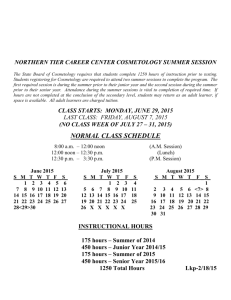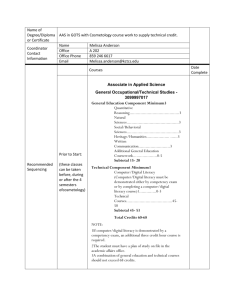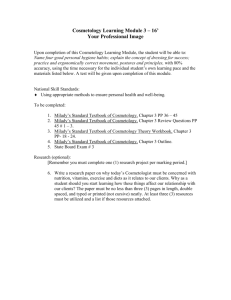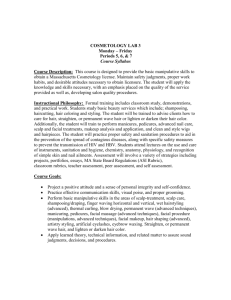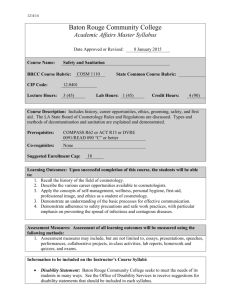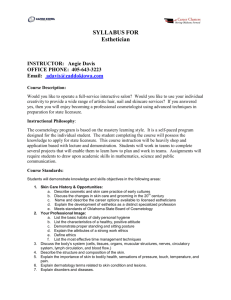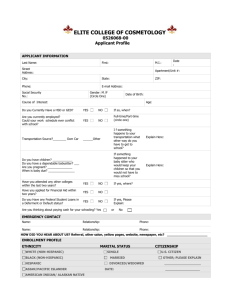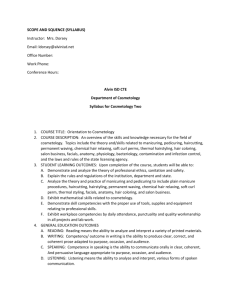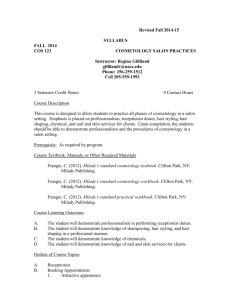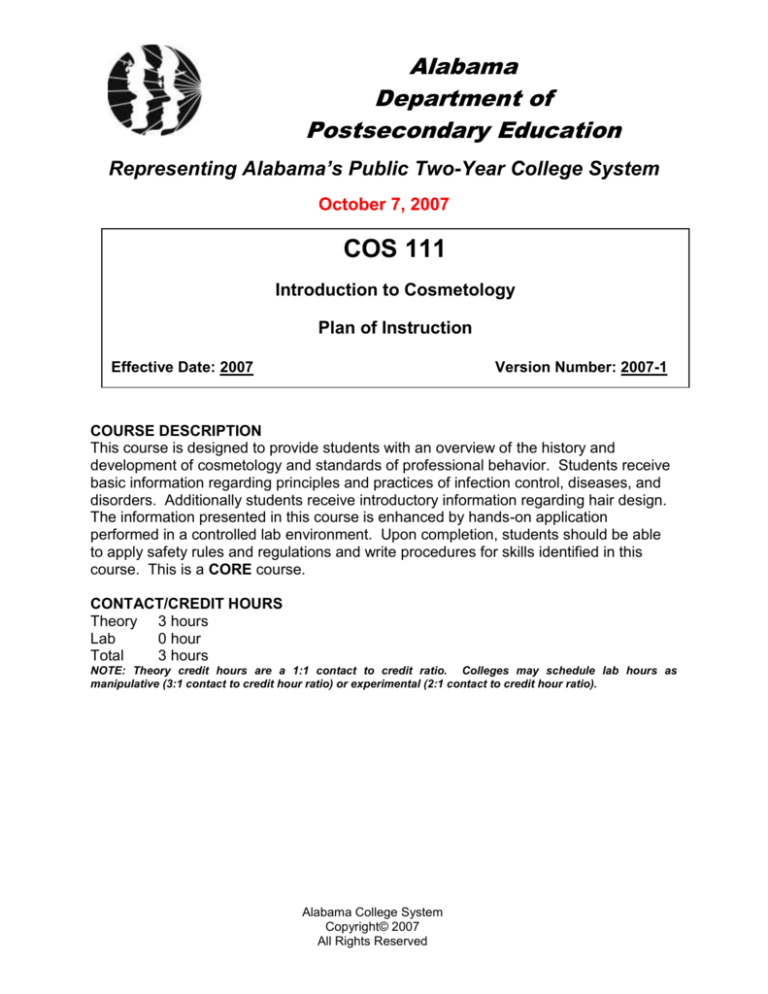
Alabama
Department of
Postsecondary Education
Representing Alabama’s Public Two-Year College System
October 7, 2007
COS 111
Introduction to Cosmetology
Plan of Instruction
Effective Date: 2007
Version Number: 2007-1
COURSE DESCRIPTION
This course is designed to provide students with an overview of the history and
development of cosmetology and standards of professional behavior. Students receive
basic information regarding principles and practices of infection control, diseases, and
disorders. Additionally students receive introductory information regarding hair design.
The information presented in this course is enhanced by hands-on application
performed in a controlled lab environment. Upon completion, students should be able
to apply safety rules and regulations and write procedures for skills identified in this
course. This is a CORE course.
CONTACT/CREDIT HOURS
Theory 3 hours
Lab
0 hour
Total
3 hours
NOTE: Theory credit hours are a 1:1 contact to credit ratio. Colleges may schedule lab hours as
manipulative (3:1 contact to credit hour ratio) or experimental (2:1 contact to credit hour ratio).
Alabama College System
Copyright© 2007
All Rights Reserved
Introduction to Cosmetology
COS 111
PREREQUISITE COURSES
As determined by college.
CO-REQUISITE COURSES
COS 112 – Introduction to Cosmetology Lab
INSTRUCTOR NOTE: Performance objectives for this course are measured in COS
112.
PROFESSIONAL COMPETENCIES/OBJECTIVES
Unless otherwise indicated, evaluation of student’s attainment of objectives is based on
knowledge gained from this course. Specifications may be in the form of, but not limited
to, manufacturer’s specifications, regulations, national and state codes, certification
agencies, locally developed lab assignments, or any combination of specifications.
PROFESSIONAL COMPETENCIES
Describe the history and career opportunities related to the profession of
cosmetology.
Explain concepts related to life skills for the cosmetology professional.
Maintain a professional image.
Apply effective communication skills while performing duties associated with
cosmetology.
Practice infection control.
Describe characteristics of various bacteria and parasites.
Apply the principles of hair style and design.
INSTRUCTIONAL GOALS
Cognitive – Comprehend concepts related to the cosmetology profession.
Psychomotor – Apply basic concepts related to the cosmetology professions.
Affective – Develop an appreciation for the profession of cosmetology.
ACS Copyright© 2007
All Rights Reserved
2
Introduction to Cosmetology
COS 111
MODULE A – COSMETOLOGY: HISTORY AND OPPORTUNITIES
PROFESSIONAL COMPETENCIES
A1.0 Describe the history and career
opportunities related to the
profession of cosmetology.
PERFORMANCE OBJECTIVES
A1.1 This module is measured cognitively.
LEARNING OBJECTIVES
A1.1.1 Describe the origins of hairstyling and barbering.
A1.1.2 Match various pioneers of modern cosmetology to their contribution.
A1.1.3 Describe advancements made in cosmetology during the nineteenth and
twentieth centuries.
A1.1.4 Describe career opportunities available to a licensed cosmetologist.
MODULE A OUTLINE:
Origins of hairstyling and barbering
Pioneers of modern cosmetology
Advancements in cosmetology
Career opportunities
ACS Copyright© 2007
All Rights Reserved
KSA
B
A
B
B
3
Introduction to Cosmetology
COS 111
MODULE B – THE PROFESSIONAL COSMETOLOGIST LIFE SKILLS
PROFESSIONAL
PERFORMANCE OBJECTIVES
COMPETENCIES
B1.0 Explain concepts related to life B1.1 This module is measured
skills for the cosmetology
cognitively.
professional.
B2.0 Maintain a professional image. B2.1 Adhere to expectations for
cosmetology professionals.
NOTE: This is an ongoing evaluation.
B3.0 Apply effective communication B3.1 Communicate professionally with
skills while performing duties
co-workers and customers.
associated with cosmetology.
NOTE: This is an ongoing evaluation.
KSA
Indicators
3c
3b
LEARNING OBJECTIVES
B1.1.1 Explain principles that contribute to personal and professional
success.
B1.1.2 Describe concepts related to self management.
B1.1.3 Describe the importance of a personal mission statement.
B1.1.4 Describe critical components of a personal mission statement.
B1.1.5 Differentiate between short and long term goals.
B1.1.6 Create a personal mission statement.
B1.1.7 Describe various techniques for effective time management.
B1.1.8 Describe techniques for effective study skills.
B1.1.9 Define ethics.
B1.1.10 Describe characteristics of quality ethics.
B1.1.11 List attributes of a positive attitude.
B1.1.12 Value the importance of developing and exhibiting a positive attitude.
B2.1.1 Describe the relationship between wellness and a professional
image.
B2.1.2 Describe the importance of maintaining a professional image.
B2.1.3 Describe the importance of maintaining personal hygiene.
B2.1.4 Describe expectations for dress for a professional cosmetologist.
B2.1.5 Describe the relationship between proper nutrition and exercise to
professional image.
B2.1.6 Describe attributes of proper posture.
B2.1.7 Describe the relationship between ergonomics and posture.
B2.1.8 Describe considerations for optimal ergonomics in the work setting.
B2.1.9 Describe ergonomic consideration when selecting and using
cosmetology implements.
B3.1.1 Describe the communication process.
B3.1.2 Describe methods to enhance communication between various
individuals in a job setting.
ACS Copyright© 2007
All Rights Reserved
B
B
B
B
B
b
b
b
A
B
A
*3
B
B
B
B
B
B
C
c
B
B
4
Introduction to Cosmetology
COS 111
MODULE B OUTLINE:
Life skills
- Principles of personal and professional success
- Concepts of self management
- Creating a personal mission statement
° Importance
° Components
° Setting goals
- Managing time
- Developing study habits
- Ethics
° Definition
° Characteristics
- Developing healthy and positive attitudes
Professional image
- Wellness
- Personal hygiene
- Dressing for success
- Stress management
- Nutrition and exercise
- Posture
- Ergonomics
Communication for success
- Process
- Total look concept
- Interpersonal communication
° Clients
° Coworkers
° Managers
ACS Copyright© 2007
All Rights Reserved
5
Introduction to Cosmetology
COS 111
MODULE C – INFECTION CONTROL, PRINCIPALS, AND PRACTICE
PROFESSIONAL COMPETENCIES
PERFORMANCE OBJECTIVES
C1.0 Describe characteristics of various
bacteria and parasites.
C1.1 This competency is measured
cognitively.
C2.0 Practice infection control.
C2.1 Use infection control techniques
while performing cosmetology
activities.
NOTE: This is an ongoing evaluation.
KSA
Indicators
3c
LEARNING OBJECTIVES
C1.1.1 List the types and classifications various types of bacteria.
C1.1.2 Describe how bacteria grow and reproduce.
C1.1.3 Differentiate between bacteria and viruses.
C1.1.4 Identify common parasites found in animals and vegetables.
C1.1.5 Differentiate between manifestations of animal and vegetable parasites.
C1.1.6 Identify parasitic conditions that prevent performing services to client.
C1.1.7 Describe characteristics of various diseases and disorders.
C2.1.1 Value the importance of infection control.
C2.1.2 Describe how various infections and contaminants are spread.
C2.1.3 Differentiate between sterilization, disinfection, and sanitation.
C2.1.4 Describe techniques for infection control.
C2.1.5 Describe safety considerations when handling infection control products.
C2.1.6 Describe universal precautions for infection control.
MODULE C OUTLINE:
Classification of bacteria
- Types
- Bacteria growth
- Bacteria and viruses
- Parasites
° Animal
° Vegetable
Diseases and disorders
- AIDS
- Hepatitis
- Staff infections
- Tuberculosis
- Other
Decontamination and infection control
- Importance of decontamination
- Methods
° Sterilization
° Disinfection
° Sanitation
- Safe handling of products
- Universal precautions
- Infection control
ACS Copyright© 2007
All Rights Reserved
A
B
B
A
B
A
B
*3
B
B
b
B
B
6
Introduction to Cosmetology
COS 111
MODULE D – PRINCIPLES OF HAIR DESIGN
PROFESSIONAL
KSA
PERFORMANCE OBJECTIVES
COMPETENCIES
Indicators
D1.0 Apply the principles of hair
D1.1 Apply the elements and principles
3b
style and design.
of hair design to enhance various
facial shapes.
LEARNING OBJECTIVES
D1.1.1
D1.1.2
D1.1.3
D1.1.4
D1.1.5
Describe safety considerations related to hair design.
Explain the elements of developing a philosophy of design.
List the five elements of hair design.
List the five principles of hair design.
Describe how to incorporate elements and principles of hair design
to enhance facial shapes.
D1.1.6 Explain considerations for client consultations.
D1.1.7 Explain critical elements of wet styling.
D1.1.8 Explain critical elements of quick service (dry) styling.
D1.1.9 Describe the use of various implements for hair styling.
D1.1.10 Describe types of braids
D1.1.11 Explain considerations for preparing for braiding.
D1.1.12 Describe types of wigs.
D1.1.13 Explain how to measure for fitting a wig.
D1.1.14 Describe considerations for caring for wigs.
D1.1.15 Describe considerations for servicing wigs.
D1.1.16 Relate hair styles and facial structures to providing optimal hair
design.
D1.1.17 Describe basic elements of men’s hair styles.
MODULE D OUTLINE:
Safety considerations
Philosophy of hair design
- Visualizing
- Inspiration
- Risk taking
Elements of hair design
Principles of hair design
Hairstyle
- Client consultation
- Wet/Dry styling
° Direction
° Implements
° Thermal
- Braiding
- Wigs
Facial structure
Men’s styles
ACS Copyright© 2007
All Rights Reserved
B
B
A
A
C
B
B
B
b
A
B
A
b
B
B
C
B
7
Introduction to Cosmetology
COS 111
LEARNING OBJECTIVES TABLE OF SPECIFICATIONS
The table below identifies the percentage of cognitive objectives for each module.
Instructors should develop sufficient numbers of test items at the appropriate
level of evaluation.
Module A
Module B
Module C
Module D
ACS Copyright© 2007
All Rights Reserved
Facts/
Nomenclature
Principles/
Procedures
A/a
25%
10%
25%
24%
B/b
75%
80%
75%
65%
Analysis/
Operating
Principles
C/c
10%
11%
Evaluation/
Complete
Theory
D/d
-
8
Introduction to Cosmetology
COS 111
Knowledge, Skills, and Attitudes (KSA) Indicators
Value
Key Word(s)
Highly
Proficient
Affective
Knowledge
Knowledge of Skills
Performance
Ability
4
Definition
Performs competency quickly and accurately. Instructs others how to do
the competency.
Performs all parts of the competency. Needs only a spot check of
completed work.
3
Proficient
2
Partially
Proficient
Performs most parts of the competency. Needs help only on hardest parts.
1
Limited Proficiency
Performs simple parts of the competency. Needs to be told or shown how
to do most of the competency.
Complete
Theory
Operating
Principles
d
c
Predicts, isolates, and resolves problems about the competency.
Identifies why and when the competency must be done and why each step
is needed.
b
Procedures
Determines step-by-step procedures for doing the competency.
a
Nomenclature
D
Evaluation
C
Analysis
Analyzes facts and principles and draws conclusions about the subject.
B
Principles
Identifies relationship of basic facts and states general principles about the
subject.
A
Facts
*5
Characterization by
Value
*4
Organization
*3
Valuing
*2
Responding
*1
Receiving
Names parts, tools, and simple facts about the competency.
Evaluates conditions and makes proper decisions about the subject.
Identifies basic facts and terms about the subject.
Acting consistently with the new value
Integrating a new value into one's general set of values, giving it some
ranking among one's general priorities
Showing some definite involvement or commitment
Showing some new behaviors as a result of experience
Being aware of or attending to something in the environment
Alpha Scale Values - Any item with an upper case letter (A, B, C, D) by itself is taught as general information on a topic. This information may be related to the
competency or encompass multiple competencies. Examples might include mathematical computations or knowledge of principles such as Ohm’s Law.
A lower case letter indicates a level of ”Knowledge of Skills." Individuals are taught information pertaining to performing a competency . These may be indicated
alone or in conjunction with a numerical scale value. A lower case letter by itself indicates the individual is not required to perform the task-just know about the task.
(example: Can state or explain procedures for doing a task).
Numerical Scale Values - The numbers reflect the levels the individual will be able to perform a competency. Number values are always accompanied by lower
case letters (i.e. 1a, 2b, 3c...etc.) in order to specify the level of knowledge of skills associated with the competency.
Example: An individual with a competency with a scale indicator of 3b has received training of knowledge of skills whereby he or she can determine the correct
procedures and perform with limited supervision; only requiring evaluation of the finished product or procedure.
Asterisk items indicate desired affective domain levels and are used to indicate the desired level for a given competency. They may be used independently or with
other indicators (i.e. 1a-*1, 2c-*3). If used with another indicator, separate with a hyphen.
NOTE: Codes indicate terminal values.
ACS Copyright© 2007
All Rights Reserved
9
Introduction to Cosmetology
COS 111
Northeast Alabama Community College
Form 1: Learning Outcomes Attachment for Career/Technical Courses
(Instructor Evaluation of Course)
Faculty regularly review the extent to which the course and program learning outcomes identified in a
course syllabus are being attained by students who complete the course. Each syllabus identifies the
assessment method that will be used to demonstrate student mastery of the desired learning outcomes
for that course. Before teaching a course, faculty should review the syllabus to understand how the
program learning outcomes will be evaluated. Once the course is complete, this form is used by the
instructor to report how well students demonstrated mastery of those course learning (and by extension,
program learning) outcomes.
Course Prefix & No.: COS 111
Instructor:
Semester:
Type of Delivery – Mark One*:
Course Title: Introduction to Cosmetology
Date:
Section Number(s):
Dual Enrollment
Online
Traditional
*Double click on the appropriate box. When the form field menu appears, select “checked” under Default value.
Note: To insert or delete rows on the table, click on Table on the tool bar.
Learning Outcome
(Industry or Professional
Competency)
Describe the history
and career
opportunities related
to the profession of
cosmetology.
Explain concepts
related to life skills
for the cosmetology
professional.
Maintain a
professional image.
Apply effective
communication
skills while
performing duties
associated with
cosmetology.
Practice infection
control.
Describe
ACS Copyright© 2007
All Rights Reserved
Evaluation Method
Evaluation Results
Explain how each learning outcome for this course is
assessed.
Of the students who earned a grade of
C or better for the course, what
percentage demonstrated attainment of
the stated outcomes?
In a designated written assignment, the
student will describe the history and
career opportunities related to the
profession of cosmetology, with at least
80% proficiency.
In a designated written assignment, the
student will explain concepts related to
life skills for the cosmetology
professional with at least 80%
proficiency.
The student will maintain a professional
image according to industry
expectations 100% of the time.
The student will apply effective
communication skills while performing
duties associated with cosmetology,
according to industry expectations 100%
of the time.
In the lab setting, the student will
observe safe infection control practices
according to industry requirements
100% of the time.
In a designated written assignment, the
10
Introduction to Cosmetology
COS 111
characteristics of
various bacteria and
parasites.
Apply the principles
of hair style and
design.
student will describe characteristics of
various bacteria and parasites with at
least 80% proficiency.
In a designated lab assignment, the
student will apply principles of hair
style and design with at least 80%
proficiency.
Use of Evaluation Results
Explain how evaluation results will be used to improve the course.
*Reviewed:
Division Chair or Program Supervisor
Date
*To be completed by Division Chair or Program Supervisor Only
ACS Copyright© 2007
All Rights Reserved
11

